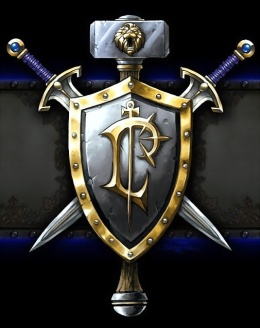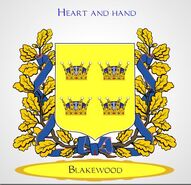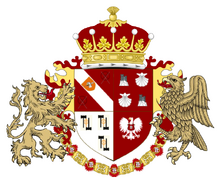
The Coat of Arms of the Kingdom of Lordaeron.
Heraldry is the profession, study, or art of creating, granting, and blazoning arms and ruling on questions of rank or protocol, as exercised by an Officer of Arms. The word, in its most general sense, encompasses all matters relating to the duties and responsibilities of officers of arms. To most, though, heraldry is the practice of designing, displaying, describing, and recording coats of arms and heraldic badges.
The origins of heraldry lie in the need to distinguish participants in combat when their faces were hidden by iron and steel helmets. Eventually a formal system of rules developed into ever more complex forms of heraldry.
Though the practice of heraldry is nearly 1,500 years old, it is still very much in use. Many cities and towns in the Eastern Kingdoms and around Azeroth still make use of arms. Personal heraldry, both legally protected and lawfully assumed, has continued to be used around the world. Heraldic societies exist to promote education and understanding about the subject.
Blazoning[]
To "blazon" arms means to describe them using the formal language of heraldry. The blazon includes a description of the arms contained within the escutcheon or shield, the crest, supporters where present, motto and other insignia. Though heraldic forms initially were broadly similar across the Eastern Kingdoms, several national styles had developed before the Age of Chaos, and artistic and blazoning styles today range from the very simple to extraordinarily complex.
Origins[]
As mentioned before, the origins of heraldry are most regularly ascribed to the need to distinguish participants in combat. Prior to the formation of the Arathorian Empire, Human and High Elven armies often bore war-banners or painted shields to better identify themselves on the battlefield. Come the foundation of the empire after the Troll Wars, the Arathorian Legion took to assigning sigils to each of its regional armies, leading to the standardization of the art.
The collapse of the empire and its subsequent division into the Eastern Kingdoms did not put an end to the need for identification on the battlefield. The great houses that now led the kingdoms of Azeroth took to assigning their personal coats of arms to their lands and armies. As the kingdoms grew in influence and sophistication, colleges dedicated to the art of heraldry were established and the profession of heraldry was born.
Modern Heraldry[]
Heraldry is used in nearly every institution within the Eastern Kingdoms. Offices of law, business organizations, universities and military regiments all bear tabards emblazoned with their respective coats of arms.
Components and Rules[]
Depending on the kingdom or land, a house's coat of arms or sigil must follow rules of appearance and design.
Shield or Lozenge[]
The main focus of a coat of arms is its escutcheon, or shield. Prior to the decrees of the Eastern Kingdoms that allowed women to become knights and landholders, a woman's coat of arms would have a diamond or oval-shaped lozenge instead of a shield.

Tinctures of Heraldry
Tinctures[]
Tinctures are the primary colors, metals, and furs used in heraldry.

The Argent Crusade uses tinctures Argent, Sable and Or.
Heraldry is essentially a system of identification, so the most important convention of heraldry is the Rule of Tincture. To provide for contrast and visibility, metals (generally lighter tinctures) must never be placed on metals, and colors (generally darker tinctures) must never be placed on colors.
Certain patterns called furs can appear in a coat of arms, though they are (rather arbitrarily) defined as tinctures, not patterns. The two common furs are ermine and vair. Ermine represents the winter coat of the stoat, which is white with a black tail. Vair represents a kind of squirrel with a blue-gray back and white belly. Sewn together, it forms a pattern of alternating blue and white shapes.
(Read more on Wikipedia.)
The Field[]
The field of a shield, or less often a charge or crest, is sometimes made up of a pattern of colors, or variation. A pattern of horizontal (barwise) stripes, for example, is called barry, while a pattern of vertical (palewise) stripes is called paly. A pattern of diagonal stripes may be called bendy or bendy sinister, depending on the direction of the stripes. Other variations include chevrony, gyronny and chequy. Wave shaped stripes are termed undy. For further variations, these are sometimes combined to produce patterns of barry-bendy, paly-bendy, lozengy and fusilly. Semés, or patterns of repeated charges, are also considered variations of the field. The Rule of Tincture applies to all semés and variations of the field.
The field of a shield in heraldry can be divided into more than one tincture, as can the various heraldic charges. Many coats of arms consist simply of a division of the field into two contrasting tinctures. These are considered divisions of a shield, so the rule of tincture can be ignored. For example, a shield divided azure and gules would be perfectly acceptable. A line of partition may be straight or it may be varied. The variations of partition lines can be wavy, indented, embattled, engrailed, nebuly, or made into myriad other forms.
(Read more on Wikipedia.)
Ordinaries[]
In the early days of heraldry, very simple bold rectilinear shapes were painted on shields. These could be easily recognized at a long distance and could be easily remembered. They therefore served the main purpose of heraldry: identification.
As more complicated shields came into use, these bold shapes were set apart in a separate class as the "honorable ordinaries". They act as charges and are always written first in blazon. Unless otherwise specified they extend to the edges of the field. Though ordinaries are not easily defined, they are generally described as including the cross, the fess, the pale, the bend, the chevron, the saltire, and the chief.

Ordinaries of Heraldry
(Read more on Wikipedia.)
Charges[]
A charge is any object or figure placed on a heraldic shield or on any other object of an armorial composition. Any object found in nature or technology may appear as a heraldic charge in armory. Charges can be animals, objects, or geometric shapes. Apart from the ordinaries, the most frequent charges are the holy cross, the lion and eagle. Other common animals are stags, wild boars, martlets, and fish. Dragons, bats, unicorns, gryphons, and more exotic monsters appear as charges and as supporters.
(Read more on Wikipedia.)
Marshalling[]
To marshal two or more coats of arms is to combine them in one shield, to express inheritance, claims to property, or the occupation of an office. This can be done in a number of ways, of which the simplest is impalement: dividing the field per pale and putting one whole coat in each half. Impalement replaced the earlier dimidiation – combining the dexter half of one coat with the sinister half of another – because dimidiation can create ambiguity between, for example, a bend and a chevron. "Dexter" means to the right from the viewpoint of the bearer of the arms and "Sinister" means to the left. The dexter side is considered the side of greatest honor.
A more versatile method is quartering, division of the field by both vertical and horizontal lines. As the name implies, the usual number of divisions is four, but the principle has been extended to very large numbers of "quarters".
The third common mode of marshalling is with an inescutcheon, a small shield placed in front of the main shield.
Helm and Crest[]
The helm and crest of a coat of arms are the helmet and its plumed crest that rest atop the shield. The crest is usually found on a wreath of twisted cloth.
When the helm and crest are shown, they are usually accompanied by a mantling. This was originally a cloth worn over the back of the helmet as partial protection against heating by sunlight. Today it takes the form of a stylized cloak hanging from the helmet. The mantling is sometimes conventionally depicted with a ragged edge, as if damaged in combat, though the edges of most are simply decorated at the emblazoner's discretion.

Coat of Arms of Columban V
Clergy often refrain from displaying a helm or crest in their coat of arms. Members of the clergy may display appropriate headwear. This often takes the form of a small crowned, wide brimmed hat called a galero with the colors and tassels denoting rank.
Mottoes[]
An armorial motto is a phrase or collection of words intended to describe the motivation or intention of the armigerous person or corporation. Mottoes are generally changed at will and do not make up an integral part of the armorial achievement. Mottoes can typically be found on a scroll under the shield. A motto may be in any language.
Supporters and Other Insignia[]
Supporters are human or animal figures or, very rarely, inanimate objects, usually placed on either side of a coat of arms as though supporting it. In many traditions, these have acquired strict guidelines for use by certain social classes.
Coronet[]
 A Baronial Coronet |
 An Earl or Count's Coronet |
 A Ducal Coronet |
|---|
If the armiger has the title of baron, hereditary knight, or higher, he may display a coronet of rank above the shield.
Another addition that can be made to a coat of arms is the insignia of a baronet or of an order of knighthood. This is usually represented by a collar or similar band surrounding the shield.
Moon Guard Heraldry Gallery[]
References & Links[]
Most text was taken and adapted from Wikipedia for fair use.
- American College of Heraldry - http://www.americancollegeofheraldry.org/achsymbols.html , info on symbolism and meaning on various coats-of-arms.
- Notre Dame Heraldic Dictionary - http://www.rarebooks.nd.edu/digital/heraldry/ , another online research tool for coats-or-arms. This one deals more in proper setup and layout.
- Glossery Of Terms - http://www.heraldsnet.org/saitou/parker/ , a ditital copy of a comprehensive glossary of heraldry terms first published in 1894.























